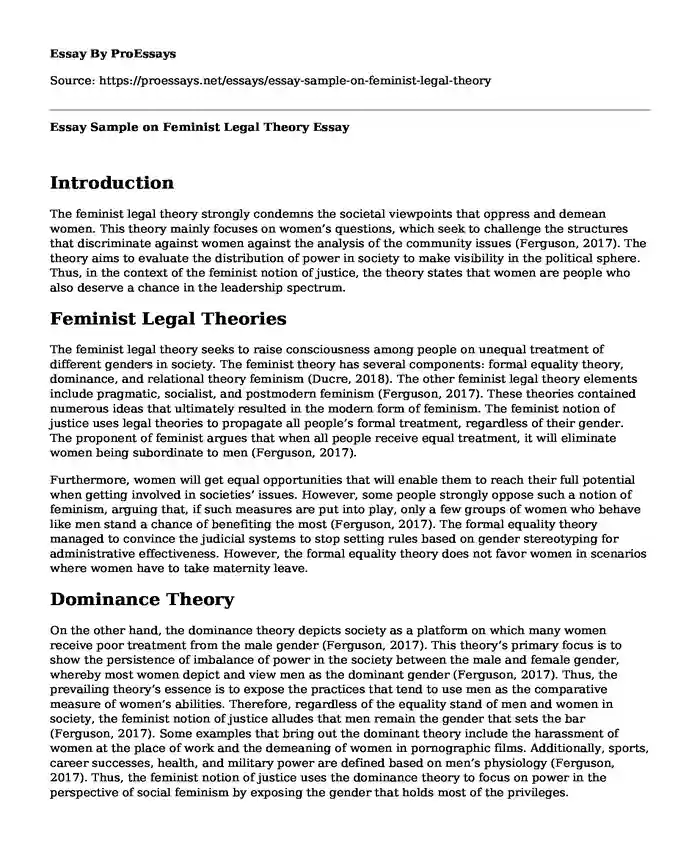Introduction
The feminist legal theory strongly condemns the societal viewpoints that oppress and demean women. This theory mainly focuses on women’s questions, which seek to challenge the structures that discriminate against women against the analysis of the community issues (Ferguson, 2017). The theory aims to evaluate the distribution of power in society to make visibility in the political sphere. Thus, in the context of the feminist notion of justice, the theory states that women are people who also deserve a chance in the leadership spectrum.
Feminist Legal Theories
The feminist legal theory seeks to raise consciousness among people on unequal treatment of different genders in society. The feminist theory has several components: formal equality theory, dominance, and relational theory feminism (Ducre, 2018). The other feminist legal theory elements include pragmatic, socialist, and postmodern feminism (Ferguson, 2017). These theories contained numerous ideas that ultimately resulted in the modern form of feminism. The feminist notion of justice uses legal theories to propagate all people’s formal treatment, regardless of their gender. The proponent of feminist argues that when all people receive equal treatment, it will eliminate women being subordinate to men (Ferguson, 2017).
Furthermore, women will get equal opportunities that will enable them to reach their full potential when getting involved in societies’ issues. However, some people strongly oppose such a notion of feminism, arguing that, if such measures are put into play, only a few groups of women who behave like men stand a chance of benefiting the most (Ferguson, 2017). The formal equality theory managed to convince the judicial systems to stop setting rules based on gender stereotyping for administrative effectiveness. However, the formal equality theory does not favor women in scenarios where women have to take maternity leave.
Dominance Theory
On the other hand, the dominance theory depicts society as a platform on which many women receive poor treatment from the male gender (Ferguson, 2017). This theory’s primary focus is to show the persistence of imbalance of power in the society between the male and female gender, whereby most women depict and view men as the dominant gender (Ferguson, 2017). Thus, the prevailing theory’s essence is to expose the practices that tend to use men as the comparative measure of women’s abilities. Therefore, regardless of the equality stand of men and women in society, the feminist notion of justice alludes that men remain the gender that sets the bar (Ferguson, 2017). Some examples that bring out the dominant theory include the harassment of women at the place of work and the demeaning of women in pornographic films. Additionally, sports, career successes, health, and military power are defined based on men’s physiology (Ferguson, 2017). Thus, the feminist notion of justice uses the dominance theory to focus on power in the perspective of social feminism by exposing the gender that holds most of the privileges.
The feminist notion of justice also uses social-justice feminism to exposes those dynamics instituted to privilege the maleness gender (Allen, 2018). Thus, the social justice feminism theory argues that even if society introduces the formal equality theory, all genders’ equal treatment does not commence on a fairground (Allen, 2018). The proponent of feminist justice urges players to consider all the variables before calling for all genders’ equality. Social justice feminism proposes that society ought to consider all aspects of the community that needs to improve instead of focusing on one element, such as leadership, power, or job opportunities.
Conclusion
Thus, the final component of the feminist legal theory is the relational feminism, which states that women were created differently but in a unique way that makes everyone proud. Hence the relational feminist theory strongly criticizes other feminist theories that try to equate women as equal power players (Allen, 2018). Inasmuch as women need equal treatment compared to their male counterparts – the community must not forget their connection and relational traits.
Cite this page
Essay Sample on Feminist Legal Theory. (2023, Nov 20). Retrieved from https://proessays.net/essays/essay-sample-on-feminist-legal-theory
If you are the original author of this essay and no longer wish to have it published on the ProEssays website, please click below to request its removal:
- Gender Gap Essay Example
- Research Paper on Cyber-Bullying Among College Students
- Feminist Legal Theory Essay Example
- Essay Example on Poverty and Esperanza's Family: Exploring 'The House on Mango Street'
- Research Paper on Religion, Terrorism & Extremism: Linked in Unpopular Beliefs
- Essay Example on US Immigration: An Economic and Social Analysis
- Women of Color: 50 Years of Media Misrepresentation & Marginalization - Research Paper







